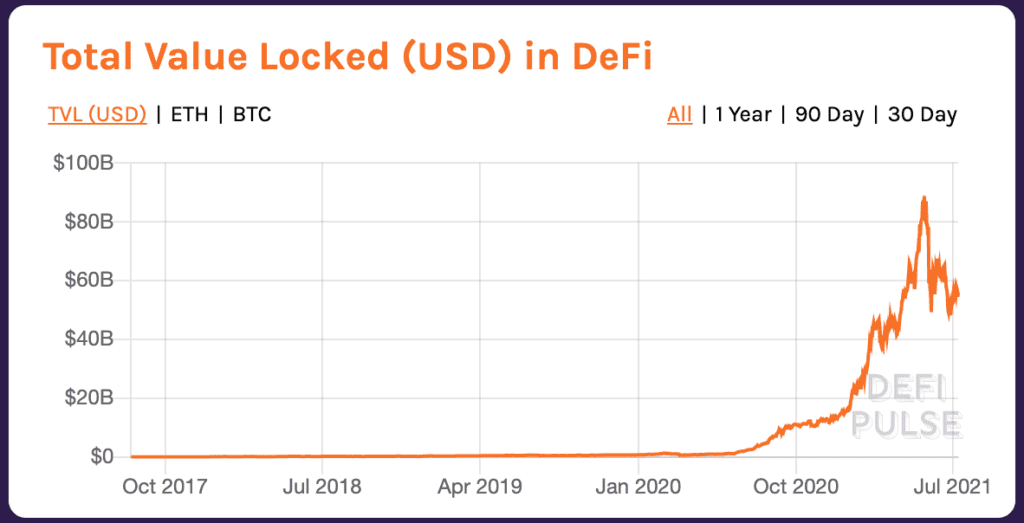People widely regard the DeFi space as a whole as a place of extremes. In this space high levels of potential reward meet equally high levels of risk. Crypto investors who have sought to enter this high-risk, and yield space generally purchase and trade tokens associated with DeFi platforms to earn cash. However, as the DeFi space continues to evolve, earning opportunities have grown more plentiful and diverse. Yield farming is One of the newer and more popular earning practices in DeFi.

What is yield farming?
Yield farming, also known as liquidity mining, allows cryptocurrency holders to earn financial rewards through decentralized liquidity protocols.
How does it work? The practice of yield farming is somewhat similar to the practice of staking. These practices involve “locking” cryptocurrency into a network or protocol in exchange for financial rewards. However, how these practices generate rewards is quite different. For example, in staking, the crypto locked in the network helps to determine which nodes will confirm transactions.
However, the locked cryptocurrency serves a different purpose in yield farming: when yield farmers lock up their tokens, they act as liquidity providers for a liquidity pool. Liquidity pools are smart contracts that provide automatic funds to decentralized exchanges, lending programs, automated market makers (AMMs), and any other DeFi platform that needs liquidity.
Essentially, these liquidity providers put their tokens into the pool so that others use them in trades and loans. In exchange, the liquidity providers receive financial rewards. This is yield farming.
How do liquidity providers receive crypto rewards?
How financial rewards are paid out can also differ between staking and yield farming. When a crypto holder stakes their tokens on a network, they will receive financial rewards. The rewards usually come in the form of that network’s native token. By contrast, yield farmers can receive their rewards in multiple kinds of crypto tokens because most yield farming protocols exist in the Ethereum ecosystem. This means that most tokens that can be farmed are ERC20 tokens.
To maximize their earning potential, yield farmers may take the token rewards from one yield farming protocol and deposit them into another. In the best circumstances, this can create a virtuous cycle of passive income.
In the best circumstances, this can provide incredibly high returns. Some yield farming protocols offer their users payouts of 30-60 percent, or even more.
Risks involved with yield farming
However, there are some risks that one should know before starting yield farming. These include:
Scams
There are many opportunities to earn massive amounts of cash in the defi space. Unfortunately, hungry scammers have followed the money. While there are many legitimate yield farming protocols, some yield farming protocols come from scammers to lure in unsuspecting crypto holders.
Before depositing your coins on any yield farming platform, ensure that the platform has a well-established reputation. Be sure that the platform’s website is located under the authentic URL and not a falsified copy.
Smart contract failure
The defi space as a whole is incredibly nascent, and new DeFi platforms launch all the time. While the developers of most of these platforms are experts in their fields, mistakes can happen–mistakes that hackers can exploit. According to the Rekt Leaderboard, which tracks defi platform exploits, 24 hacks had occurred between January and May of 2021.
You can use yield farming as a mechanism to increase or decrease volatility exposure to the general market, but make sure you know how your farm affects your risk profile. It's never too late, till it's too late.
— glimmery (@Glimmerycoin) May 26, 2021
What are impermanent loss?
According to Binance Academy, automated market makers (AMMs) are essential “robots” that are “always willing to quote you a price between two assets.” Essentially, AMMs are decentralized trading platforms that do not match buyers with sellers to execute trades: instead, they rely on liquidity pools.
The risk of impermanent loss comes from the fact that AMMs don’t always automatically update token prices based on market movements. This can create arbitrage opportunities for traders. However, liquidity providers can be left holding the bag. For example, imagine that a token price falls by 50% on a centralized exchange. Will not immediately reflect the price on an AMM.
Therefore, arbitrage traders can use this opportunity to sell their tokens on AMMs platforms at a higher price than on the centralized exchange. When this happens, liquidity providers have to pay the price. Because their tokens are locked in the liquidity pool, sharp downward movements in token prices can force them to suffer losses.
To avoid impermanent loss, it’s important to understand the way that a yield farming platform operates. Liquidity providers can also use community resources to learn about a yield farm’s reputation, as well as whether or not the farm has safeguards against impermanent loss in place.
What are composability risk?
Defi platforms consist of pieces of software that users colloquially refer to as “money legos.” These DeFi “Lego bricks” can be a financial product or service that developers can freely combine with others. This is one of the many promises of DeFi: that it can help to create simple yet complex systems of automated financial services.
However, one of the risks of this “lego”-based system is that the others can follow if one piece is downed. Therefore, when choosing a yield farm or any DeFi protocol, ensure that each of its individual pieces has been audited for resilience against exploitation.
How to start yield farming?
There are several yield farming platforms in the DeFi space, and more pop up all the time. Compound Finance, Aave, Synthetic, MakerDAO, Uniswap, SushiSwap, and Yearn.
Each of these platforms offers a unique set of rewards–and each one carries its own set of risks. Before choosing a platform to farm yield on, make sure you understand the possible dangers that the platform carries and the safeguards that it has against those dangers.
